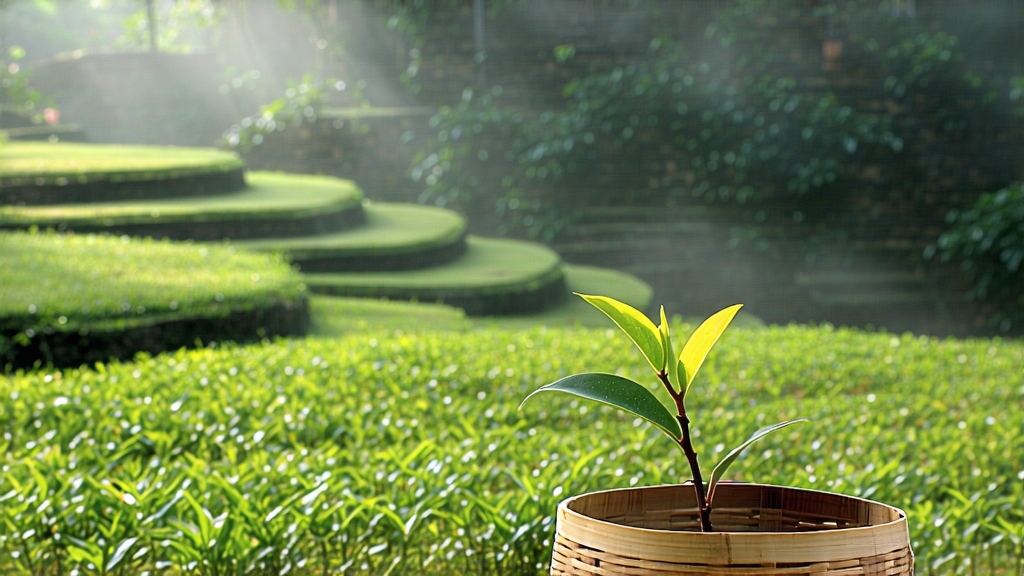
Tucked high on the northern rim of the Sichuan Basin, where humid clouds roll up the southern slopes of the Min Shan range, lies the mist-locked terrace of Meng Ding Shan, the “Bright Summit.” It was here, 1,200 metres above the busy Chengdu plain, that Buddhist monks first coaxed the down-covered buds of a local tea tree into a liquor the colour of late-afternoon sunlight. Their creation—Meng Ding Huang Ya, literally “Meng Summit Yellow Bud”—is the least-known yet most aristocratic member of China’s yellow-tea family. While green tea grabs the spotlight and pu-erh fills collectors’ vaults, Meng Ding Huang Ya survives in tiny lots, made only during a ten-day window each spring, and carried quietly to the cups of those who still believe that tea can taste like mountain mist solidified.
Historical whispers
The written record begins in the Tang dynasty (618-907), when the mountain’s Ganlu Temple offered its “sweet-dew” tea to the court in Chang’an. By the Song (960-1279) the buds had become imperial tribute; palace archives list 1,200 jin (600 kg) demanded annually. When the Ming court moved north, the tea travelled the Min River, then the Yangtze, then the Grand Canal, arriving in Beijing wrapped in silk and bamboo-leaf. An imperial edict of 1543 specifically exempted Meng Ding growers from grain tax in exchange for 350 kg of the finest buds—an early example of tea as hard currency. The Qing kept the tradition alive, but the chaos of the nineteenth century broke the tribute chain; by 1949 only a few kilograms were still being handmade for local monks. Rediscovery came in 1978 when retired master Chen Shangong returned to the mountain, gathered three old craftsmen, and spent three seasons reconstructing the lost “men-huang” (sealed yellowing) step. Today fewer than 300 kg of authentic Meng Ding Huang Ya reach the market each year, most pre-sold to collectors in Guangzhou, Taipei and, increasingly, Berlin.
The micro-climate that colours the bud
Meng Ding Shan enjoys a rare double cloak: warm, wet air rising from the Sichuan basin meets cold Himalayan fronts sliding over the plateau. The result is 280 fog-bound days a year, 85 % humidity, and a UV-filtered light that forces the tea bush to produce extra theanine and a lower catechins-to-polyphenol ratio. The local cultivar, Camellia sinensis var. sinensis ‘Ganlu 1’, keeps its buds hairy and ivory-green even at full maturity. When plucked one-leaf-and-bud on the first sunny morning after the Qingming festival, the fresh leaf already carries a faint milky aroma that signals low bitterness and high soluble sugars.
Pluck: the mountain’s stopwatch
Picking begins at 05:30, when leaf temperature is below 12 °C, and ends at 09:00, before the sun burns off the dew. Only buds between 15 mm and 22 mm, with a stem shorter than 3 mm, are accepted. A skilled picker gathers just 200 g per hour; 60,000 buds are needed for one kilogram of finished tea. The leaf is carried down the slope in shallow bamboo baskets lined with banana leaf to prevent bruising; oxidation must be kept below 2 % until the tea reaches the village workshop.
Kill-green: the gentle arrest
Unlike green-tea makers who blast leaf at 280 °C, Meng Ding craftsmen use a 120 °C brass-bottomed wok, hand-polished for thirty years to a mirror sheen. The leaf is tossed for exactly 90 seconds—long enough to denature polyphenol oxidase but short enough to preserve the hairs. The master listens: when the rustle turns from splash to whisper, kill-green is complete. A quick shake in a rattan sieve drops the temperature to 45 °C within 30 seconds, locking in a chestnut note that will later deepen into cocoa.
Rolling: the spiral of Sichuan
Next comes rolling, but not the violent kneading used for oolong. The still-warm leaf is cupped in a linen cloth and rolled gently on a bamboo mat, forming loose spirals that resemble sleeping snails. This “cold rolling” lasts eight minutes and releases just enough cellular juice to coat the bud surface, preparing it for the signature yellowing